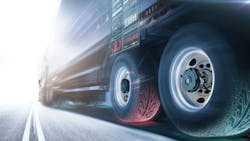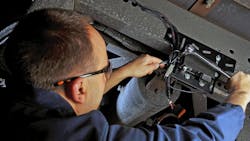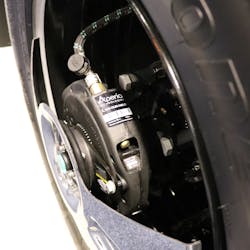The case for TPMS and if it will be made mandatory
Tire maintenance can be the trickiest aspect of commercial vehicle fleet management. Tires routinely rank as one of the top three main cost items for fleets (along with fuel and drivers), so gathering as much data as possible about their health and performance has always been a challenge for fleet managers. That’s the long-term problem.
There are day-to-day management issues as well. Simply keeping tires at their correct air pressure is—hands down—a fleet’s most powerful tool for ensuring good fuel economy, safety, and long tire life. But getting drivers to actually put a gauge on a tire stem and get a pressure reading has always been an iffy proposition. Many drivers consider simply whacking a tire with a stout wooden stick to be an adequate tire-check procedure. (Spoiler alert: it’s not.)
Add-on tire pressure monitoring systems (TPMS) were developed to address all of these issues. Initially offered as add-on systems for trailers, TPMS offered fleets direct monitoring of tire pressures on a trailer. Early systems simply alerted the driver if there was a pressure issue—a feature that was revolutionary at the time. Typically, fleets set their own thresholds. Boyle Transportation, for example, sets its Bendix SmarTire TPMS to alert operators at 15% underinflation.
According to the American Trucking AssociationsTechnology & Maintenance Council, a tire continuously underinflated by 20% will have nearly one-third less life, while 40% underinflation cuts a tire’s expected life by half.“Underinflated tires are a foreshadowing of premature tire wear, tire failure, or even a tire-related accident in the future,” noted Judith Monte, VP of marketing & client success at Aperia Technologies, a provider of tire inflation and TPMS solutions. “That can be seen in statistics from the National Highway Traffic Safety Administration (NHTSA), which show 35% of accidents attributed to ‘vehicle malfunctions’ are primarily attributed to tire-related problems.”
Tire failures occur often and with significant consequences, Monte continued. In fact, she said, tires need to be checked and maintained more than any other truck component and disproportionately benefit from the addition of automation paired with sensors and analytics.
Today’s TPMS generally use telematics to alert both a driver and a fleet manager to an underinflated tire. In both cases, the information allows prompt action to be taken to correct the issue before a catastrophic failure occurs. TPMS is, to put it mildly, a good idea whose time has come.
“It is especially important to know the tire pressure on commercial vehicles,” stressed Jim Sharkey, VP of global sales and marketing at Pressure Systems International (P.S.I.). “Unlike a passenger car, it is more difficult to ‘feel’ soft, underinflated tires, so having the pressures monitored is very important to preventing roadside calls and improving highway safety.”
For those reasons, Sharkey said that both TPMS and automatic tire inflation systems (ATIS), which take things a step further by actually pumping air from a truck’s air compressor into a low-pressure tire, can dramatically improve the efficiency and accuracy of pre-trip inspections.
He also challenged the notion that pre-trips are done 100% of the time and performed accurately.
“They’re not,” Sharkey alleged. “And using tire-bats or kicking a tire to ‘check’ its air pressure have proven to be largely ineffective and misleading.”
The thumper method might be quick and cheap, but it will cost the fleet and driver in flat tires and roadside calls and can create unsafe driving conditions.
“According to NHTSA, vehicles driving on under-inflated tires are three times more likely to be involved in a crash compared to vehicles with proper inflation,” added Jamie Barnett, senior manager, tire-centric product management, Bridgestone Mobility Solutions. “And from a fuel economy standpoint, under-inflated tires lead to a 3% reduction in fuel efficiency. If you apply that to a Class 8 sleeper, that 3% reduction equates to approximately $2,503 per vehicle annually in fuel expense. Multiply that over a business’s entire fleet, and you can see how great of an impact it will have on your bottom line.”Another strong factor driving fleet adoption in the U.S. is that TPMS is a proven money-saver for fleets, added Mark Molitor, senior product manager, chassis and suspensions, Link Manufacturing.
“Studies have shown that 25% of all dual tire assemblies have tires that differ in pressure by more than 5 psi,” he said. “And while 5 psi may not sound like much, a tire that is just 5 psi lower creates a 5/16” difference in diameter. In a dual tire arrangement, the larger tire will drag the smaller one an estimated 13’ for every mile driven, prematurely wearing out the tire and potentially leading to a safety hazard. Tires 15% under inflation also reduce mpg by 2.5%, impacting profits. So, from that perspective, TPMS is a proven winner for fleets when it comes to extending tire life while controlling operating costs.”
According to Jonathan Gravell, VP of business development at P.S.I., the company’s TireView TPMS solution also frees up fleet yard workers from pounding pavement walking to each and every trailer to check the tires. Instead, they know right where to go.
“I’m not going to go check 2,000 trailers; I’m going to go check the 20 that I could see are in red, and walk straight to them,” he said.
Gravell also noted TireView helped one regional pickup and delivery fleet cut roadside calls by 70%. And with economic inflation soaring, it’s more important than ever to ensure an underinflated tire doesn’t create an emergency roadside event. FleetNet America found that the average event cost (without towing) for a power unit rose by 12.9% from Q1 2021 to Q1 2022, while for a trailer it increased by 19.7%.
TPMS has been such a success globally now that it’s being mandated on new trucks and trailers in countries around the world. Which begs the obvious question: Will similar regulations come to the United States soon as well?Inflation intervention
Europe, long a leader in mandating safety systems on commercial vehicles, has already taken the lead in mandating TPMS, said Nicola Zingraf-Bolton, head of digital solutions, CVS Americas, ZF. “New European regulations began in July of 2022 that require all new truck trailers to be fitted with TPMS,” Zingraf-Bolton explained. “However, at ZF, we currently do not see a push for similar regulations here in the U.S. The biggest reason is because TPMS has gained large market share in fleet applications. The technology is already very common in the U.S. today. So, we really see the market itself taking care of tire monitoring in a way that [the] government doesn’t feel any pressure to step in and mandate the technology.”
Fred Andersky, director, government and industry affairs, Bendix Commercial Vehicle Systems, agreed with that assessment. “At this point in time, there doesn’t seem to be much interest in mandating TPMS on Classes 7 and 8 commercial vehicles in the U.S.,” Andersky said. “I see NHTSA’s current efforts focused more on autonomous emergency braking systems, electric vehicles, and autonomous vehicles.”
However, Andersky cautioned, given the rapid pace of technology today, things could change. “As we get to more automated and autonomous vehicle technologies, I believe TPMS has to be part of the package of sensors and systems used on these vehicles,” he noted. “Ensuring the vehicle is in a safe state for driving requires that the system know that tires are inflated along with other information such as tread depth, wheel-bolt tightness, brake-pad wear, and other operational factors.”To bolster his view, Andersky pointed to the Transportation Recall Enhancement, Accountability, and Documentation (TREAD) Act, which was passed in 2000, in order to increase consumer safety through mandates assigned to NHTSA. “Because the TREAD Act uses the term ‘vehicle,’ instead of specifying a specific class, many folks interpret this to mean the TREAD Act includes trucks,” Andersky said. “This may give the agency flexibility in the future to mandate TPMS and other systems on commercial vehicles. But that is just speculation on my part. We haven’t heard anything about requests for NHTSA to mandate this technology yet.”
While the Tire Industry Association has not taken an official position on TPMS mandates, Kevin Rohlwing, SVP of Training at the Tire Industry Association (TIA), told Fleet Maintenance, “As a rule, the Association is against regulations that result in higher costs for fleets, so we would likely support the fleet position if it was proposed.”
He also noted the TREAD Act provided a major reason for the medium- and heavy-duty trucking sectors to not follow suit.
“When the TREAD Act mandated TPMS on vehicles under 10,000 lb. GVWR, each manufacturer approached it differently, so there are multiple systems with no interchangeability,” he said. “In order for TPMS [regulations] on trucks to work in the U.S., there would have to be universal connectivity with every tractor and trailer manufacturer. Mounted tire programs would be a nightmare keeping track of sensors.”
He also noted that ATIS can be regarded as a type of TPMS, and thousands of new trailers are spec’d with those systems each year. According to Hendrickson, which makes the TIREMAAX Pro ATIS solution, ATIS is adopted on 70% of new trailers in North America.
Another factor that must be considered are ever-stricter rounds of U.S. Environmental Protection Agency (EPA) and California Air Resource Board (CARB) emissions mandates aimed at improving fuel economy and reducing emissions for diesel-powered trucks, Monte said.
“It’s worth noting that the Greenhouse Gas Phase 2 emissions rule (which currently regulates diesel truck exhaust emissions in the U.S.) promotes using TPMS and ATIS to reduce heavy-duty vehicle emissions,” Monte said. But, she added, there’s been quite a bit of back-and-forth on the issue lately. “At first, due to more aggressive California state legislation and the higher-than-expected shifts to zero-emissions vehicles (ZEV) before 2027 in many trucking segments, the EPA signaled the possibility that emissions credits produced in these segments by advanced technology multipliers might allow fleets to forgo many available sustainable technologies, such as ATIS and TPMS, on diesel-powered vehicles,” she explained. “However, there has since been a course-correction on that front, with new proposed legislation continuing to support the use of ATIS and TPMS to generate legislative credits.”
Monte said that time will tell if tire pressure management technologies will be mandated in the U.S. and Canada. But she does think it’s likely as emissions mandates become stricter in the future. “Before the Clean Air Act, environmental legislation in the United States tended to follow EURO legislation,” she added. “So, if I were a betting woman, and I tend to be, I would say it is only a matter of time until the technology is mandated in the United States as well.”
About the Author
James Alfred
James Alfred is a freelance journalist with more than 15 years of experience in the trucking industry.




